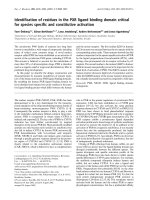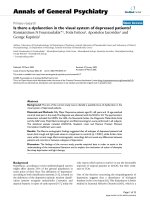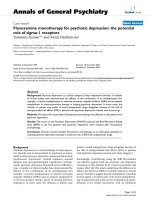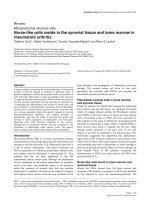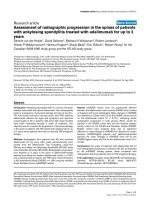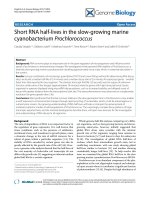Báo cáo y học: " Predisposing factors for delirium in the surgical intensive care unit" pps
Bạn đang xem bản rút gọn của tài liệu. Xem và tải ngay bản đầy đủ của tài liệu tại đây (55.97 KB, 6 trang )
commentary review reports
research
Available online />Research article
Predisposing factors for delirium in the surgical intensive care unit
Mustafa Aldemir*, Sakir Özen
†
, Ismail H Kara
‡
, Aytekin Sir
†
and Bilsel Baç*
*Department of General Surgery, Dicle University, Faculty of Medicine, Diyarbakir, Turkey
†
Department of Psychiatry, Dicle University, Faculty of Medicine, Diyarbakir, Turkey
‡
Department of Family Practice, Dicle University, Faculty of Medicine, Diyarbakir, Turkey
Correspondence: Mustafa Aldemir,
CI = confidence interval; DG = delirious group; HBP = hepatobiliopancreatic diseases; ICU = intensive care unit; LSH = length of stay in hospital;
LSICU = length of stay in the ICU; NDG = non-delirious group; OR = odds ratio.
Abstract
Background Delirium is a sign of deterioration in the homeostasis and physical status of the patient.
The objective of our study was to investigate the predisposing factors for delirium in a surgical
intensive care unit (ICU) setting.
Method Between January 1996 and 1997, we screened prospectively 818 patients who were
consecutive applicants to the general surgery service of Dicle-University Hospital and had been kept in
the ICU for delirium. All patients were hospitalized either for elective or emergency services and were
treated either with medication and/or surgery. Suspected cases of delirium were identified during daily
interviews. The patients who had changes in the status of consciousness (n = 150) were consulted with
an experienced consultation-liaison psychiatrist. The diagnosis of delirium was based on Diagnostic and
Statistical Manual of Mental Disorders (revised third edition) criteria and established through psychiatric
interviews. Patients were divided into two groups: the ‘delirious group’ (DG) (n = 90) and the ‘non-
delirious group’ (NDG) (n = 728). During delirium, all abnormal findings related to physical conditions,
laboratory features, and additional diseases were evaluated as probable risk factors of delirium.
Results Of 818 patients, 386 (47.2%) were male and 432 (52.8%) were female. Delirium developed in
90 of 818 patients (11%). The cases of delirium in the DG were more frequent among male patients
(63.3%) than female patients (36.7%) (χ
2
= 10.5, P = 0.001). The mean age was 48.9 ± 18.1 and 38.5
± 13.8 years in the DG and NDG, respectively (t = 6.4, P = 0.000). Frequency of delirium is higher in the
patients admitted to the Emergency Department (χ
2
= 43.6, P = 0.000). The rate of postoperative
delirium was 10.9%, but there was no statistical difference related to operations between the DG and
NDG (χ
2
= 0.13, P = 0.71). The length of stay in the ICU was 10.7 ± 13.9 and 5.6 ± 2.9 days in the DG
and NDG, respectively (t = 0.11, P = 0.000). The length of stay in hospital was 15.6 ± 16.5 and 8.1 ±
2.7 days in the DG and NDG, respectively (t = 11.08, P = 0.000). Logistic regression was used to
explore the associations between probable risk factors and delirium. Delirium was not correlated with
conditions such as hypertension, hypo/hyperpotassemia, hypernatremia, hypoalbuminemia,
hypo/hyperglycemia, cardiac disease, emergency admission, age, length of stay in the ICU, length of stay
in hospital, and gender. It was determined that conditions such as respiratory diseases (odds ratio [OR] =
30.6, 95% confidence interval [CI] = 9.5–98.4), infections (OR = 18.0, 95% CI = 3.5–90.8), fever (OR =
14.3, 95% CI = 4.1–49.3), anemia (OR = 5.4, 95% CI = 1.6–17.8), hypotension (OR = 19.8, 95% CI =
5.3–74.3), hypocalcemia (OR = 30.9, 95% CI = 5.8–163.2), hyponatremia (OR = 8.2, 95% CI =
2.5–26.4), azotemia (OR = 4.6, 95% CI = 1.4–15.6), elevated liver enzymes (OR = 6.3, 95% CI =
1.2–32.2), hyperamylasemia (OR = 43.4, 95% CI = 4.2–442.7), hyperbilirubinemia (OR = 8.7, 95% CI =
2.0–37.7) and metabolic acidosis (OR = 4.5, 95% CI = 1.1–17.7) were predicting factors for delirium.
Conclusion We determined that conditions such as respiratory diseases, infections, fever, anemia,
hypotension, hypocalcemia, hyponatremia, azotemia, elevated liver enzymes, hyperamylasemia,
hyperbilirubinemia and metabolic acidosis were predicting factors for delirium.
Keywords delirium, intensive care unit, predisposing factors
Received: 5 March 2001
Revisions requested: 9 July 2001
Revisions received: 31 July 2001
Accepted: 1 August 2001
Published: 6 September 2001
Critical Care 2001, 5:265-270
This article is online at />© 2001 Aldemir et al, licensee BioMed Central Ltd
(Print ISSN 1364-8535; Online ISSN 1466-609X)
Critical Care October 2001 Vol 5 No 5 Aldemir et al
Introduction
Delirium is not a disease in itself, but a syndrome of acute
cerebral inefficiency affecting the brain in various ways. It
creates a deleterious effect on cognitive functions such as
consciousness, orientation, perception, attention, short-term
memory, judgment and abstract thinking [1,2]. Delirium is a
temporary condition, which can occur suddenly or slowly over
a period of hours or days. A single episode lasts up to 1
week. The symptoms may be so slight they go unnoticed or
so serious they could be life threatening. The clinical signs of
delirium are changeable all day, and are usually more serious
during early morning or night. Temporary changes in clinical
signs are important characteristics of delirium. While the
patient may appear well and communicative during an obser-
vation, changes in orientation could occur a few minutes later
[1,3]. Delirium is typically an indicator of a physical pathology
and a worsening prognosis [1,4–6]. It is commonly unrecog-
nized or misdiagnosed by physicians treating critically ill
patients. The rate of misdiagnosis has been reported as
32–67% in various reviews [6,7]. Clinical evaluation is the
most important criterion and electroencephalography is the
most useful test for diagnosis.
Although delirium can be experienced in all age groups, it has
an increased frequency at more advanced ages [2,3]. Risk
factors determined for the syndrome include: age [7–12],
imbalance of electrolyte [5,7,10], hypotension [1,7], hyper-
glycemia [1,7,8], azotemia [7,12], fever/hypothermia and
infections [5,7,10–15], use of multiple drugs and withdrawal
of alcohol [7,8,10–16], male sex [7,10], severe diseases
such as cancer, cerebrovasculary or cardiopulmonary
disease, malnutrition and burn [1,5,7,8,15–18], patients who
have been operated on and kept in ICUs [4,10–16,19], and
psychosocial environment [1,3,5,20]. Furthermore, subclinical
cerebral damage, increased adenylate cyclase in the central
nervous system, and nutritional status identified by albumin
level are predisposing factors for postoperative delirium [1].
Interleukin-2, monoclonal antibodies and ifosfamide have also
been suspected recently as factors [15]. The aim of the
present study was to confirm and/or determine predisposing
factors for delirium.
Materials and methods
Between January 1996 and 1997, we screened prospectively
for delirium 818 consecutive general surgery patients at the
Dicle-University Hospital. All patients, whether hospitalized for
elective or emergency services, or whether treated with med-
ication or surgery, were kept for a period of time in our ICU.
Ten nurses, four physicians and four staff work daily in the ICU
department. The ICU has 24 beds with continuous non-inva-
sive monitoring and ventilators. There are windows in the bed
areas of the ICU. Trained clinician-researchers carried out
daily structured interviewers with the patients from admission
until hospital discharge. Suspected cases of delirium were
identified during the daily interview. Patients with changes in
their status of consciousness (n = 150) were consulted by an
experienced consultation-liaison psychiatrist (SÖ).
Delirium was defined as an organic mental disorder involving
a confusional state with attention deficit, disorganized think-
ing and a fluctuating course and acute development. The
diagnosis of delirium was based on the criteria from the Diag-
nostic and Statistical Manual of Mental Disorders (revised
third edition) and established through a psychiatric interview
(Table 1). Patients who had history of severe dementia or had
abused psychoactive drugs and alcohol were excluded from
our study. Delirium was diagnosed in 90 patients. Patients
were divided into two groups: the DG (n = 90) and the NDG
(n = 728). Analysis of whole blood count, arterial blood
gases, biochemistry and urine, culture antibiograms of blood,
urine or other secretions, and radiological examinations, such
as chest X-ray, were performed on all delirious and non-deliri-
ous patients. All abnormal findings during delirium, related to
physical conditions, laboratory features, and additional dis-
eases, were evaluated as probable risk factors for delirium.
Findings for risk factors included respiratory disease (chronic
obstructive pulmonary disease, cor pulmonale, pneumothorax,
hemothorax, etc.), symptomatic infection, fever (> 38°C),
hypotension (symptomatic, or systolic blood pressure
< 80 mmHg), anemia (< 25% htc), hypertension
(> 90/160 mmHg), hypo/hyperpotassemia (< 3 or >6 mEq/l),
hypocalcemia (< 8 mg/dl), hypo/hypernatremia (<130 and
>150 mmol/l), elevated level of serum urea nitrogen
Table 1
Diagnostic and Statistical Manual of Mental Disorders (revised
third edition) diagnostic criteria for delirium [21]
A. Reduced ability to maintain and shift attention to external stimuli
B. Disorganized thinking, as indicated by rambling, irrelevant, or
incoherent speech
C. At least two of the following:
1. Reduced level of consciousness
2. Perceptual disturbances: misinterpretations, illusions, or
hallucinations
3. Disturbance of sleep–wake cycle with insomnia or daytime
sleepiness
4. Increased or decreased psychomotor activity
5. Disorientation to time, place, or person
6. Memory impairment
D. Abrupt onset of symptoms (hours to days), with daily fluctuation
E. Either one of the following:
1. Evidence from history, physical examination, or laboratory tests
of specific organic etiologic factor(s)
2. Exclusion of non-organic mental disorders when no etiologic
organic factor can be identified
commentary review reports
research
(>100 mg/dl), elevated level of hepatic enzymes (high alanine
aminotransferase, high aspartate aminotranferase), hyperamy-
lasemia (> 300 U/l), hyperbilirubinemia (>10 mg/dl total biliru-
bin), metabolic acidosis, hypoalbuminemia (< 3 g/dl),
hypo/hyperglycemia (< 60 or > 300 mg/dl), cardiac disease
(symptomatic coronary heart disease and arrhythmias, heart
failure, etc.), emergency admission status, age, length of stay
in the ICU (LSICU), length of stay in hospital (LSH), and
gender. Patients were grouped according to their diagnosis.
The groupings included hepatobiliopancreatic diseases
(HBP), fistulas, traumas, acute abdominal diseases, malignan-
cies, ileus, and others. The patients who had delirium were
treated initially for etiological diseases, but when the treat-
ment was insufficient medication with diazepam or haloperi-
dole was added.
Biostatistical evaluation was carried out on an IBM-compati-
ble personal computer using SPSS 10.1 software. The
Student t test for continuing variables and the chi-square test
for categoric variables were used. To identify factors indepen-
dently related to the development of delirium, we also per-
formed forward stepwise (conditional) logistic regression.
P < 0.05 was considered statistically significant.
Results
Of 818 patients, 386 (47.2%) were male and 432 (52.8%)
were female. Delirium developed in 90 of 818 patients
(11%). The cases of delirium in the DG were more frequent
among male patients (63.3%) than female patients (36.7%)
(χ
2
= 10.5, P = 0.001). The mean age was 48.9 ± 18.1 and
38.5 ± 13.8 years in the DG and NDG consecutively (t = 6.4,
P = 0.000). While 81.1% of delirious patients were admitted
in an emergency state, the remaining 18.9% was admitted in
elective states. Frequency of delirium was higher in the
patients admitted through the Emergency Department
(χ
2
= 43.6, P = 0.000). The rate of postoperative delirium
was 10.9%, but there were no statistical differences related
to operation between the DG and NDG (χ
2
= 0.13, P = 0.71)
(Table 2). The LSICU was 10.7 ± 13.9 and 5.6 ± 2.9 days in
the DG and NDG, respectively (t = 0.11, P = 0.000). The
LSH was 15.6 ± 16.5 and 8.1 ± 2.7 days in the DG and
NDG, respectively (t = 11.08, P = 0.000). Delirium was diag-
nosed in 12.9% of patients with HBP, in 50% of those with
fistulas, in 20.8% of those exposed to trauma, in 8.2% of
those with acute abdominal diseases, in 9.3% of those with
malignancies, and in 18.4% of patients with ileus (Table 3).
Psychomotor activity increased in 56.78% of delirious
patients and decreased in 43.3%. Of delirious patients,
31.1% were treated with diazepam and 13.3% were treated
with haloperidole.
Table 4 shows that the following factors were all associated
with an increased risk of strongly developing delirium: respira-
tory diseases (OR = 30.6, 95% CI = 9.5–98.4), infections
(OR = 18.0, 95% CI = 3.5–90.8), fever (OR = 14.3, 95% CI =
4.1–49.3), anemia (OR = 5.4, 95% CI = 1.6–17.8), hypoten-
sion (OR = 19.8, 95% CI = 5.3–74.3), hypocalcemia (OR =
30.9, 95% CI = 5.8–163.2), hyponatremia (OR = 8.2, 95%
CI = 2.5–26.4), azotemia (OR = 4.6, 95% CI = 1.4–15.6),
elevated liver enzymes (OR = 6.3, 95% CI = 1.2–32.2), hyper-
amylasemia (OR = 43.4, 95% CI = 4.2–442.7), hyperbilirubine-
mia (OR = 8.7, 95% CI = 2.0–37.7) and metabolic acidosis
(OR = 4.5, 95% CI = 1.1–17.7). Delirium was not correlated
with conditions such as hypertension, hypo/hyperpotassemia,
hypernatremia, hypoalbuminemia, hypo/hyperglycemia, cardiac
disease, emergency admission, age, LSICU, LSH, and gender.
Discussion
Delirium, a syndrome associated with long hospital stays and
high rates of morbidity and mortality [10], is a sign of deterio-
ration in the homeostasis and physical status of the patient
[17]. Approximately 10–15% of patients on general surgical
wards and 15–25% of patients on general medical wards
experience delirium during their hospital stay. Approximately
30% of patients in surgical ICUs and cardiac ICUs, and
40–50% of patients who are recovering from hip fractures
have an episode of delirium [1,22]. The delirium rate is
10–40% in cancer patients [23], but increases to 85% in
patients with advanced malignancies [15]. Delirium is seen in
18% of the patients when the ICU facility has windows, but
rises to 40% of the cases when the ICU facility has no
windows [11]. It has been determined that preoperative risk
factors for delirium were older age [24–26], prior cognitive
impairment [24,25], pre-existing cerebrovascular or other
brain diseases, history of prior delirium [25], preoperative
abnormal sodium [24], vision or hearing impairment [24,26]
and regular use of psychotropic drugs before admission [24].
In this series, 11% of our patients had delirium; 34.4%
(n = 31) of these were older than 60 years. The youngest
patient was 15 years old, and the eldest was 91 years old. All
Available online />Table 2
Characteristics of all patients
DG NDG Statistics
n (%) n (%) χ
2
* P value
Gender
Female 33 (36.7) 399 (54.8) 10.5 0.001
Male 57 (63.3) 329 (45.2)
Admission
Emergency 73 (81.1) 322 (44.2) 43.6 0.000
Elective 17 (18.9) 406 (55.8)
Kind of treatment
Operative 83 (92.2) 679 (93.3) 0.13 0.71
Non-operative 7 (7.8) 49 (6.7)
DG, Delirious group; NDG, non-delirious group. * Pearson chi-square
test.
of our patients, most of whom were younger than 60 years
old, were kept in an ICU with windows. This may be responsi-
ble for the low frequency of delirium in this series. Although
the age of delirious patients were higher than that of the NDG
(t = 6.4, P = 0.000), age was not determined as a predicting
factor for delirium (P > 0.05, in the logistic regression test) in
our study. The rate of delirium has a predominance in males
[10,27]. We found that the number of delirious male patients
was significantly higher than female patients (χ
2
= 10.5,
P = 0.001), although gender was not a predictive factor for
delirium (P > 0.05, in the logistic regression).
The prevalence of delirium in the Emergency Department was
9.6% [28]. In this series, the rate of delirium was 18.5% in
emergency admissions, similar to Kishi’s series (16%) [29],
but emergency admission was not considered a factor for
delirium.
The etiology of delirium is complex and usually consists of
multiple factors. In 80–95% of delirious patients, the etiology
is secondary to organic factors, but it is difficult to interpret
further details [5–7]. Imbalances of electrolytes, metabolic
changes, intoxication or absence of drugs, trauma of head
and postoperative state are the most common etiological
factors. Other less common factors are infections, intracranial
lesions, coma, fever, cardiovasculary diseases, poisons, poly-
medication and deficiencies of vitamins [4,5,26,28,30]. Anti-
cholinergic drugs are also commonly accused agents [5].
Surgical stress and infectious fever are common factors in
geriatric patients [14]. Francis et al [12] reported that abnor-
mal sodium levels, fever/hypothermia and azotemia were
independent predictors for delirium in elderly patients.
Foreman [31] determined that hypernatremia, hypokalemia,
hyperglycemia, azotemia, hypotension and polymedication
were predictors for delirium in a prospective study. Some pre-
disposing factors determined in our study were respiratory
disease (14.1%), hypotension (17%), anemia (16.4%),
hyponatremia (11.7%), azotemia (10.8%), and metabolic aci-
dosis (7.6%). The major neurotransmitter hypothesized as
involved in delirium is acetylcholine, and the major neuro-
anatomical area is the reticular formation [2]. Electrolyte
imbalance and azotemia may be responsible for the decrease
in acetylcholine activity in the brain.
Symptomatic infection and fever were other independent pre-
dictors of delirium. Delirium has been reported in infectious
diseases such as diverticulitis [32], pneumonia [33] and
typhoid fever [34]. Certainly, fever is concomitant with many
infections and experimental data have supported a casual
relation between fever and delirium. Fever and infection corre-
lated with delirium in our study as independent predictors in
the multivariate logistic regression. Cytokines and/or bacterial
toxins and cerebral metabolic changes may be causes of the
mental changes associated with infection.
To perform specific treatment, it is important to determine the
etiological factor. Arterial blood gases and current and past
vital signs should be checked to establish whether cerebral
hypoxemia or hypertensive encephalopathy is present. The
patient with hypoglycemic-induced delirium virtually always
has a history of insulin-dependent diabetes mellitus. Hypo-
glycemic delirium is also hyperadrenergic. Hypotension can
result from multiple etiologies, such as decreased cardiac
output from a myocardial infarction, cardiac failure or arrhyth-
mias, and anemia. All medical conditions that cause hypoten-
Critical Care October 2001 Vol 5 No 5 Aldemir et al
Table 3
The rate of delirium according to disease
Disease DG, n (%) NDG, n (%) Total (n)
HBP 19 (12.9) 128 (87.1) 147
Fistulas 10 (50.0) 10 (50.0) 20
Trauma 22 (20.8) 84 (79.2) 106
AAD 13 (8.2) 145 (91.8) 158
Malignancies 4 (9.3) 39 (90.7) 43
Ileus 9 (18.4) 40 (81.6) 49
Other 13 (4.4) 282 (95.6) 295
Total 90 (11) 728 (89) 818
DG, Delirious group; NDG, non-delirious group; AAD, acute abdominal
diseases; HBP, hepatobiliopancreatic diseases.
Table 4
Predicting factors for delirium
% of total Odds 95% confidence
Factor patients (n = 818) ratio* interval*
Disease or symptom variables
Respiratory disease 14.1 30.6 9.5–98.4
Infection 14.1 18.0 3.5–90.8
Fever 26.7 14.3 4.1–49.3
Hypotension 17 19.8 5.3–74.3
Anemia 16.4 5.4 1.6–17.8
Laboratory variables
Hypocalcemia 7.7 30.9 5.8–163.2
Hyponatremia 11.7 8.2 2.5–26.4
Elevated level of 10.8 4.6 1.4–15.6
serum urea nitrogen
Elevated level of 7.3 6.3 1.2–32.2
hepatic enzymes
Hyperamylasemia 2 43.4 4.2–442.7
Hyperbilirubinemia 5.5 8.7 2.0–37.7
Metabolic acidosis 7.6 4.5 1.1–17.7
* Forward stepwise (conditional) logistic regression.
sion can lead to a decrease in brain oxygenation [1]. In this
study, we predicted that respiratory diseases, anemia, and
hypotension were effective in delirium by decreasing brain
oxygenation.
Research into patients who developed hepatic failure sug-
gests that the gamma-aminobutyric acid system is important
in the development of hepatic encephalopathy (i.e. hypoactive
delirium caused by liver dysfunction). Specifically, endoge-
nous benzodiazepine-like substances may play a role in delir-
ium associated with hepatic failure [1]. In our study, delirium
was seen in 12.9% of HBP. The abnormalities, such as ele-
vated level of hepatic enzymes, hyperbilirubinemia, hypocal-
cemia and hyperamylasemia associated with HBP, were
strongly predictive factors for delirium. This condition showed
that early intervention was important in HBP cases.
The existence of hyperactive, hypoactive, or mixed clinical
subtypes of delirium is widely accepted. The hyperactive
subtype was more frequent (46.5%) than the unspecified
(27.3%) and hypoactive subtypes (26.2%) [35]. In a series
consisting of cancer patients, it was observed that the hyper-
active type (which has a shorter duration) is the most com-
monly seen subtype of delirium, with a rate of 71% [36]. In
our study, 56.7% of delirious patients had hyperactive
subtype.
There is no specific drug used for management of delirium.
The first step of treatment is trying to calm down the patient
and to identify the underlying cause [1,3,13]. The second
step is treating the causative factors, when determinable. If
causative factors are undeterminable, then efforts should be
directed to preventing permanent damage [1,3]. Butyrophe-
nones (haloperidole, thiothixene and droperidole), and benzo-
diazepins (diazepam, oksazepam and lorazepam) are the
recommended drugs for sedation and preventing agitation
[16,37,38]. In this series, we treated the etiological factors in
all patients and gave diazepam to 31.1% of the patients and
haloperidole to 13.3% of the patients.
Both surgeons and anesthesiologists could reduce the inci-
dence of delirium in the patients who are at high risk by care-
fully ordering and monitoring the dosages of drugs, and
watching for signs of cardiac ischemia during the periopera-
tive period [8,10].
The practice of polymedication should not be given up [8,30].
The goal in diagnosis is to discover reversible causes for
delirium. In this study series, we determined that conditions
such as disease or symptom variables (respiratory diseases,
symptomatic infections, fever, anemia, hypotension) and labo-
ratory variables (hypocalcemia, hyponatremia, azotemia, ele-
vated liver enzymes, hyperamylasemia, hyperbilirubinemia,
and metabolic acidosis) were predicting factors for delirium.
Clinicians must identify specific etiologies when possible and
apply appropriate treatment.
Competing interests
None declared.
References
1. Wise MG: Delirium: In American Psychiatric Press Textbook of
Neuropsychiatry. Edited by Hales RE, Yudofsky SC. Washington,
DC: American Psychiatric Press; 1987:89-105.
2. Kaplan HI, Sadock BJ: Synopsis of Psychiatry, 8th edn. Baltimore,
USA: Lippincott Williams & Wilkins; 1998.
3. Lipowski JZ: Delirium (Acute confusional states). JAMA 1987,
258:1789-1792.
4. Haller E, Binder R: Delirium, dementia, amnestic disorders. In:
Review of General Psychiatry, 4th edn. Edited by Goldman HH.
London: Appleton & Lange; 1992:176-181.
5. Lipowski ZJ: Transient cognitive disorders (Delirium, acute
confusional states) in the elderly. Am J Psychiatry 1983, 140:
1426-1436.
6. Dubos G, Gonthier R, Simeone I, Camus V, Schwed P, Cadec B,
Diana MC, Burtin B, Melac M: Confusion syndromes in hospi-
talized aged patients: polymorphism of symptoms and
course. Prospective study of 183 patients. Rev Med Interne
1996, 17:979-986.
7. Inouye SK: The dilemma of delirium: Clinical and research
controversies regarding diagnosis and evaluation of delirium
in hospitalized elderly medical patients. Am J Med 1994, 97:
278-288.
8. Marcantonio ER, Goldman L, Mangione CM, Ludwing LE, Muraca
B, Haslauer CM, Donaldson MC, Whittemore AD, Sugarbaker DJ,
Poss R: A clinical prediction rule for delirium after elective
noncardiac surgery. JAMA 1994, 271:134-139.
9. Radanov BP, Basetti C: Delirium: occurrence, diagnosis and
therapy. Schweiz Rundsch Med Prax 1995, 84:1335-1341.
10. Schor JD, Levkoff SE, Lipsitz LA, Reilly CH, Cleary PD, Rowe JW,
Evans DA: Risk factors for delirium in hospitalized elderly.
JAMA 1992, 267:827-831.
11. Wilson LM: Intensive Care Delirium: The effect of outside
deprivation in a windowless unit. Arch Intern Med 1972, 130:
225-226.
12. Francis J, Martin D, Kapoor WN: A prospective study of delirium
in hospitalized elderly. JAMA 1990, 263:1097-1101.
13. Hege SG: Postoperative transitory syndrome and delirium.
Anesthetist 1989, 9:443-451.
14. Lazaro L, Marcos T, Cirera E, Pujol J: Delirium in an elderly pop-
ulation admitted at a general hospital. Med Clin Barc 1995,
104:329-333.
15. Zimberg M, Berenson S: Delirium in patients with cancer:
Nursing assessment and intervention. Oncol Nurs Forum
1990, 17:529-538.
16. Fish DN: Treatment of delirium in the critically ill patient. Clin
Pharm 1991, 10:456-466.
17. Özkan S: Psychiatric Medicine: Consultation-Liaison Psychiatry
[in Turkish], 1st edn. Istanbul: Roche Publications; 1993.
18. Stiefel F, Razavi D: Common psychiatric disorders in cancer
patients. II. Anxiety and acute confusional states. Support Care
Cancer 1994, 2:233-237.
19. Hayashi H, Maeda Y, Morichika H, Miyama T, Suzuki T: Surgical
stress and transient postoperative psychiatric disturbances in
aged patients studied using the Yamaguchi University Mental
Disorder Scale. Surg Today 1996, 26:413-418.
20. Rabins PV: Psychosocial and management aspect of delirium.
Int Psychogeriatr 1991, 3:319-324.
21. American Psychiatric Association: Diagnostic and Statistical
Manual of Mental Disorders, 3rd edn rev. Washington, DC: Amer-
ican Psychiatric Association; 1987:97-124.
22. Dubin WR, Field NL, Gastfriend DR: Postcardiotomy delirium: a
critical review. J Thorac Cardiovasc Surg 1979, 77:5865-5894.
23. Massie MJ, Holland J, Glass E: Delirium in terminally ill cancer
patients. Am J Psychiatry 1983, 140:1048-1050.
24. Galanakis P, Bickel H, Gradinger R, Von Gumppenberg S, Forstl
H: Acute confusional state in the elderly following hip surgery:
incidence, risk factors and complications. Int J Geriatr Psychia-
try 2001, 16:349-355.
25. Litaker D, Locala J, Franco K, Bronson DL, Tannous Z: Preopera-
tive risk factors for postoperative delirium. Gen Hosp Psychia-
try 2001, 23:84-89.
Available online />commentary review reports
research
26. Gallinat J, Moller H, Moser RL, Hegerl U: Postoperative delirium:
risk factors, prophylaxis and treatment. Anaesthesist 1999,
48:507-518.
27. Millar HR: Psychiatric morbidity in elderly surgical patients. Br
J Psychiatry 1981, 138:17-20.
28. Elie M, Rousseau F, Cole M, Primeau F, McCusker J, Bellavance
F: Prevalence and detection of delirium in elderly emergency
department patients. CMAJ 2000, 163:977-981.
29. Kishi Y, Iwasaki Y, Takezawa K, Kurosawa H, Endo S: Delirium in
critical care unit patients admitted through an emergency
room. Gen Hosp Psychiatry 1995, 17:371-379.
30. Geary SM: Intensive care unit psychosis revisited: Under-
standing and managing delirium in the critical care setting.
Crit Care Nurs Q 1994, 17:51-63.
31. Foreman MD: Confusion in the hospitalized elderly: incidence,
onset, and associated factors. Res Nurs Health 1989, 12:21-
29.
32. Normal DC, Yoshikawa TT: Intraabdominal infections in the
elderly. J Am Geriatr Soc 1983; 31:677-684.
33. Verghese A, Berk SL: Bacterial pneumonia in the elderly. Medi-
cine 1983, 62:271-285.
34. Verghese A: The “typhoid state” revisited. Am J Med 1985, 79:
370-372.
35. Camus V, Gonthier R, Dubos G, Schwed P, Simeone I: Etiologic
and outcome profiles in hypoactive and hyperactive subtypes
of delirium. J Geriatr Psychiatry Neurol 2000, 13:38-42.
36. Olofsson SM, Weitzner MA, Walentine AD, Baile WF, Meyers CA:
A retrospective study of the psychiatric management and
outcome of delirium in the cancer patient. Support Care
Cancer 1996, 4:351-357.
37. Berger I, Waldhorn RE: Analgesia, sedation and paralysis in
the intensive care unit. Am Family Physician 1995, 51:166-172.
38. Seneff MG, Mathews RA: Use of haloperidole infusions to
control delirium in critically ill adults. Ann Pharmacother 1995,
29:690-693.
Critical Care October 2001 Vol 5 No 5 Aldemir et al
